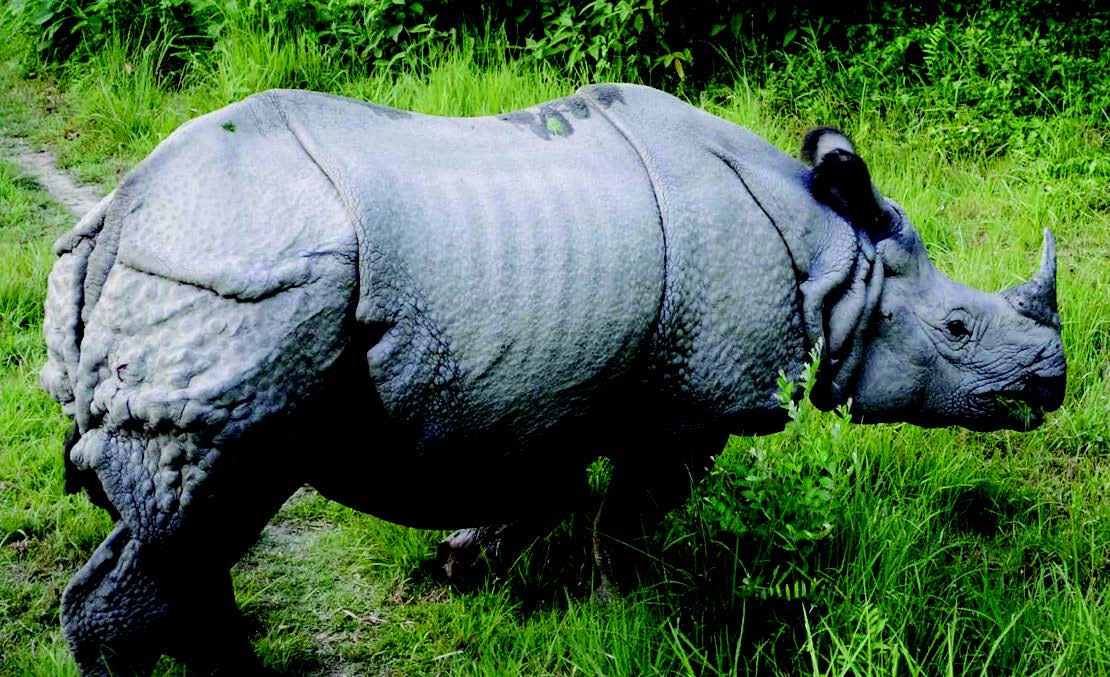Rhinos continue to die in Chitwan National Park

By Indira Aryal
Kathmandu, Feb. 28 Nepal has achieved remarkable success to tackle the poaching of one-horned rhinos in the last decade, however, it has witnessed a sharp rise in their deaths from unknown and natural causes.
The number of rhinos dying of natural cause, as the government say, has increased in Chitwan National Park (CNP) in the last few years. In 2019 alone, 49 rhinos died; among them, 36 died in CNP alone. The exact cause of the rhinos’ death has not yet been confirmed.
In the current fiscal year, 18 rhinos have already died due to natural and unidentified cause. To identify the causes of deaths, a committee led by deputy director general of the Department of National Parks and Wild Life Conservation (DNPWLC), Ram Chandra Kandel has also been formed.
According to Kandel, in the ecosystem there occur clashes between the wild animals, and deaths from the fight between animals is natural. One baby rhino died in a tiger attack and another died in the attack of a male rhino, he informed.
“To identify the causes of deaths and measures to protect them, a team of experts had visited Chitwan National Park recently and the report will be presented within a month to the concerned ministry,” Kandel informed.
After a large number of rhinos died last year, a team of experts will also be formed to find out the real cause of the deaths, he said. The grass land is not sufficient for the wild animals, and it is hard to find out how many rhinos died in the jungle in the previous year, he said.
“This time, we had conducted interaction with the people in three different places of the conservation sites for the protection and conversation of rhinos and we are working to find out better options,” Kandel said. The research would focus on various aspects of the national park like availability of food and the condition of wetlands and water resources, according to the Department.
According to Information Officer and spokesperson of the Department, Bishnu Prasad Shrestha, the study would also find an answer to whether climate change was making it difficult for rhinos to tackle the environment.
Shrestha said that the major cause of rhino’s death around one decade ago was poaching. “The government has declared zero poaching since 2011, however, deaths from the natural causes have been increasing since last year,” he said.
According to rhino census 2015, the country had 645 rhinos in four national parks -- 605 in CNP, 29 in Bardiya National Park, eight in Suklaphata National Park and three in Parsa National Park. Another census is going to start from mid-March 2020 across the country, the DNPWLC said.
“There are many reasons for natural death of the rhinos. One of the most common is the battle with other animals regarding territories and other things. Other causes may be diseases and infections, floods, landslides and ageing,” Shrestha informed. Most of the baby rhinos died due to attack of male rhinos, he said. One died falling into a safety tank, one in mustard field and another due to electric shock, Shrestha learned.
The dead rhinos are buried in the territories after conducting filed study. The horns and hoofs of the rhinos are taken out before burying them. “All the samples of dead rhinos were collected for the investigation, but none of the rhinos were found to have died due to illness from infectious diseases,” he said.
The Department of Animal Service and an animal lab in Sauraha examined the samples but the government has no expert human resource to take samples immediately after the death for advanced study. “We don’t have advanced lab inside the country so all the samples should be sent abroad for test but due to lack of human resource to collect samples soon after the death, we are unable to send samples for better result,” Shrestha informed.
“We have tested the water quality of the conservation areas to see whether the rhinos died due to contamination of water, but the water was found to be safe,” he said.
A study on the carrying capacity of the conservation areas is underway since last year and the study would be released after ascertaining the number of rhinos next month, the Department said.
The Department is also working on habitat intervention. Last year, over 80 wetlands were constructed in the CNP. The government is also expanding grassland every year for better management of the conservation sites. This year alone, the government is planning to expand the grassland in over 700 hectares. Out of total area of CNP, 10 per cent is covered with grassland.
Recent News

Do not make expressions casting dout on election: EC
14 Apr, 2022
CM Bhatta says may New Year 2079 BS inspire positive thinking
14 Apr, 2022
Three new cases, 44 recoveries in 24 hours
14 Apr, 2022
689 climbers of 84 teams so far acquire permits for climbing various peaks this spring season
14 Apr, 2022
How the rising cost of living crisis is impacting Nepal
14 Apr, 2022
US military confirms an interstellar meteor collided with Earth
14 Apr, 2022
Valneva Covid vaccine approved for use in UK
14 Apr, 2022
Chair Prachanda highlights need of unity among Maoist, Communist forces
14 Apr, 2022
Ranbir Kapoor and Alia Bhatt: Bollywood toasts star couple on wedding
14 Apr, 2022
President Bhandari confers decorations (Photo Feature)
14 Apr, 2022











